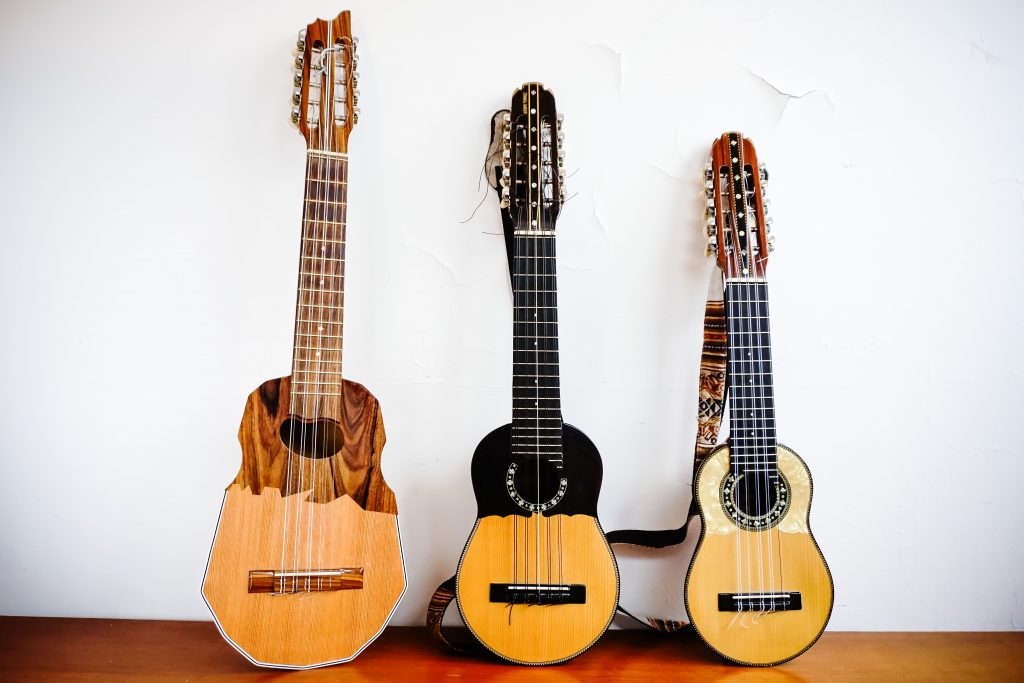
Charango, Ronroco, and Charangón: differences, tunings, and uses

One of the artists who has greatly contributed to spreading the sound of the charango and Andean music is undoubtedly Gustavo Santaolalla, author of numerous soundtracks (notably the ones for Last of Us, The Motorcycle Diaries, 21 grams ) and of a particular album called Ronroco, where he recorded some of his most famous pieces. Santaolalla, who is Argentinean, has always expressed his love for the instrument that he specifically titled the album after: the ronroco. But what are the differences between the charango and the ronroco?
Any charanguista who has listened carefully to the album realizes that while the sound is certainly similar to that of the charango, the tones are different from the more usual ones, making them less comfortable to play on the charango. The timbre also changes. It is soft, sweet, and perhaps less sharp than that of the traditional charango. One might rightly ask then, what exactly is the ronroco that Santaolalla uses?
There is indeed some confusion due to historical and geographical reasons. The modern charango, as well known by those who play and study it closely, is a prototype among many variants of similar instruments, all spread across the Andean region. Over the past fifty years, however, especially thanks to the invaluable work of Mauro Nuñez Caceres, the true Bolivian father of the modern charango, there has been a standardization of the forms and tones of what is effectively a family of chordophones. Currently, in Bolivia, the charango is mainly accompanied by two other instrument variants. The first is called the charangón, while the second is called the ronroco.
In Argentina, however, things are different: the way instruments of this family are named differs from Bolivia. Both a Bolivian and an Argentinean refer to the charango as a the same instrument, but in Argentina there is no instrument called charangón; its name is ronroco. The Bolivian ronroco, on the other hand, is known as mediana in Argentina, although it is not a widely recognized instrument. This difference creates significant challenges when trying to purchase a specific instrument in Bolivia or Argentina. Here is a table of correspondences that makes everything clearer:
| Bolivia | Argentina | Register | Scale Lenght (cm) | Scale Lenght (in) |
| Charango | Charango | Alto | 34 to 39 | 13.4 to 15.4 |
| Charangón | Ronroco | Tenor | 41 to 45 | 16.1 to 17.7 |
| Ronroco | Mediana | Baritone | 45 to 50 | 17.7 to 19.7 |
For clarity, on this website, all names used refer to the Bolivian nomenclature. Let’s consider the first column of this table. Now, let’s look in detail at the characteristics of these instruments. The differences between charango, ronroco, and charangón are mainly related to the size of the instrument and the length of the scale length. And since a picture is worth a thousand words, here’s a comparison of the three instruments side by side:

In the center, you can see the Bolivian charangón – called ronroco in Argentina – which is essentially a slightly larger charango in size, with a scale length typically around 42 cm. This instrument is tuned with a fourth interval below that of the charango. The tuning of the individual strings is as follows:

The Bolivian ronroco, on the other hand, has a scale length ranging from 45 to 50 cm. Its traditional tuning is exactly one octave lower than that of the charango, and in its current form, it was made famous by the group Los Kjarkas, who used it purely for accompaniment purposes. They are credited with inventing the ronroco, although it must be acknowledged that within the vast array of Bolivian instruments, there exist traditionally similar local variants.
One can observe the presence of a low octave on the fifth pair of strings (G) and the fourth pair of strings (C), while the high E string on the first pair is eliminated: in other words, the third pair and the first pair play exactly the same note without octaves (E). This tuning is actually a very common temple in the Bolivian region known as Temple Diablo and is particularly used in k’alampeo. In the following image, you can compare the two tunings:

The relationship between these instruments – with others less known like the walaycho also included – is practically the same as other families of instruments we are more familiar with. Think of the violin, viola, and cello, or the saxophone in its various versions from soprano to baritone. Therefore, we can affirm that the charango corresponds to the alto register, the charangon to the tenor, and the ronroco to the baritone. This insight dates back to a great charango master, in some way the father of all modern charanguistas: Mauro Núñez Cáceres.
However, unlike the saxophone, the charango is not a transposing instrument. The same fingering on a charango and a charangon produces two different chords: the C major on the charango corresponds to a G major on the charangon, and so on.
The instrument with which Gustavo Santaolalla plays and with which he recorded his most famous pieces is therefore an Argentine Ronroco, which corresponds to the Bolivian charangon. So if you wish to buy a similar instrument from a Bolivian luthier, you should not ask for a ronroco, but a charangon!
